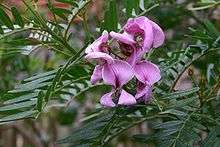Podalyrieae
| Podalyrieae | |
|---|---|
 | |
| Virgilia divaricata | |
| Scientific classification | |
| Kingdom: | Plantae |
| (unranked): | Angiosperms |
| (unranked): | Eudicots |
| (unranked): | Rosids |
| Order: | Fabales |
| Family: | Fabaceae |
| Subfamily: | Faboideae |
| (unranked): | Core genistoids |
| Tribe: | Podalyrieae (Benth.) Cardoso et al. 2013[1][2] |
| Genera[1][3] | |
|
See text. | |
| Synonyms[4] | |
| |
The tribe Podalyrieae is one of the subdivisions of the plant family Fabaceae.
Description
The Podalyrieae arose 30.5 ± 2.6 million years ago (in the Oligocene) in the fynbos (Cape Floristic Region) of South Africa and is still mostly found there.[5][6] All members of the tribe exhibit either nonsprouting or sprouting fire survival strategies.[7] Many species are pollinated by insects, especially carpenter bees,[4] while others are pollinated by sunbirds or rodents.[5]
The members of this tribe consistently form a monophyletic clade in molecular phylogenetic analyses.[1][4][5][8][9][10][11][12][13][14] The tribe does not currently have a node-based definition, but several morphological synapomorphies have been identified:
"imparipinnately compound leaves, axillary racemose inflorescences, carboxylic acid esters of quinolizidine alkaloids, and the isoflavone 3′-hydroxydaidzein as a major seed flavonoid"[1][5][15] as well as "strongly reduced or absent bracteoles and the occurrence of persistent antipodals in the female gametophyte."[4]
Subtribes and Genera
Subtribe Xiphothecinae
- Amphithalea Eckl. & Zeyh.
- Xiphotheca Eckl. & Zeyh.
Subtribe Podalyriinae
- Calpurnia E. Mey.
- Liparia L.
- Podalyria Willd.
- Stirtonanthus B.-E. van Wyk & A. L. Schutte
- Virgilia Poir.
Unassigned
References
- 1 2 3 4 Cardoso D, Pennington RT, de Queiroz LP, Boatwright JS, Van Wyk BE, Wojciechowski MF, Lavin M (2013). "Reconstructing the deep-branching relationships of the papilionoid legumes". S Afr J Bot. 89: 58–75. doi:10.1016/j.sajb.2013.05.001.
- ↑ Wojciechowski MF. (2013). "Towards a new classification of Leguminosae: Naming clades using non-Linnaean phylogenetic nomenclature". S Afr J Bot. 89: 85–93. doi:10.1016/j.sajb.2013.06.017.
- ↑ USDA, ARS, National Genetic Resources Program (17 January 2003). "GRIN species records of Podalyrieae". Germplasm Resources Information Network—(GRIN) [Online Database]. National Germplasm Resources Laboratory, Beltsville, Maryland. Retrieved 4 August 2010.
- 1 2 3 4 Schutte AL; Van Wyk BE; Schutte-Vlok AL; Forest F.; Van der Bank M. (1998). "Evolutionary relationships in the Podalyrieae and Liparieae (Fabaceae) based on morphological, cytological, and chemical evidence". Pl Syst Evol. 209 (1–2): 1–31. doi:10.1007/BF00991521.
- 1 2 3 4 5 Boatwright JS; Savolainen V; Van Wyk B-E; Schutte-Vlok AL; Forest F.; Van der Bank M. (2008). "Systematic position of the anomalous genus Cadia and the phylogeny of the tribe Podalyrieae (Fabaceae)". Syst Bot. 33 (1): 133–147. doi:10.1600/036364408783887500.
- ↑ Linder HP. (2003). "The radiation of the Cape flora, southern Africa". Biol Rev Camb Philos Soc. 78 (4): 597–638. doi:10.1017/S1464793103006171. PMID 14700393.
- ↑ Schutte AL, Vlok JH, Van Wyk BE (1995). "Fire-survival strategy—a character of taxonomic, ecological and evolutionary importance in fynbos legumes". Pl Syst Evol. 195 (3–4): 243–259. doi:10.1007/BF00989299.
- ↑ Cardoso D, de Queiroz LP, Pennington RT, de Lima HC, Fonty É, Wojciechowski MF, Lavin M (2012). "Revisiting the phylogeny of papilionoid legumes: new insights from comprehensively sampled early-branching lineages". Am J Bot. 99 (12): 1991–2013. doi:10.3732/ajb.1200380.
- ↑ Käss E, Wink M (1996). "Molecular evolution of the Leguminosae: Phylogeny of the three subfamilies based on rbcL-sequences". Biochem Syst Ecol. 24 (5): 365–378. doi:10.1016/0305-1978(96)00032-4.
- ↑ Käss E, Wink M (1997). "Phylogenetic Relationships in the Papilionoideae (Family Leguminosae) Based on Nucleotide Sequences of cpDNA (rbcL) and ncDNA (ITS 1 and 2)". Mol Phylogenet Evol. 8 (1): 65–88. doi:10.1006/mpev.1997.0410. PMID 9242596.
- ↑ Doyle JJ, Doyle JL, Ballenger JA, Dickson EE, Kajita T, Ohashi H (1997). "A phylogeny of the chloroplast gene rbcL in the Leguminosae: taxonomic correlations and insights into the evolution of nodulation". Am J Bot. 84 (4): 541–554. doi:10.2307/2446030. PMID 21708606.
- ↑ Wink M, Mohamed GI (2003). "Evolution of chemical defense traits in the Leguminosae: mapping of distribution patterns of secondary metabolites on a molecular phylogeny inferred from nucleotide sequences of the rbcL gene". Biochem Syst Ecol. 31 (8): 897–917. doi:10.1016/S0305-1978(03)00085-1.
- ↑ Crisp MD, Gilmore S, Van Wyk BE (2000). "Molecular phylogeny of the genistoid tribes of papilionoid legumes". In Herendeen PS, Bruneau A. Advances in Legume Systematics, Part 9. Royal Botanic Gardens, Kew. pp. 249–276. ISBN 184246017X.
- ↑ LPWG [Legume Phylogeny Working Group] (2013). "Legume phylogeny and classification in the 21st century: progress, prospects and lessons for other species-rich clades". Taxon. 62 (2): 217–248. doi:10.12705/622.8.
- ↑ Van Wyk B-E. (2003). "The value of chemosystematics in clarifying relationships in the Genistoid tribes of papilionoid legumes". Biochem Syst Ecol. 31 (8): 875–884. doi:10.1016/S0305-1978(03)00083-8.
- ↑ van der Bank M, Chase MW, van Wyk BE, Fay MF, van der Bank FH, Reeves G, Hulme A (2002). "Systematics of the tribe Podalyrieae (Fabaceae) based on DNA, morphological and chemical data". Bot J Linn Soc. 139 (2): 159–170. doi:10.1046/j.1095-8339.2002.00051.x.
| Wikimedia Commons has media related to Podalyrieae. |
| Wikispecies has information related to: Podalyrieae |
This article is issued from Wikipedia - version of the 9/6/2016. The text is available under the Creative Commons Attribution/Share Alike but additional terms may apply for the media files.